●HOME > 100 Years of History
100 Years of History
Changing with the times, growing with the community
| 1918 | Decision made to build hospital. Input and suggestions sought from Torasaburo Araki, Chancellor of Kyoto Imperial University and Junjiro Shimazono, Dean of the University’s School of Medicine. |
| 1923 | 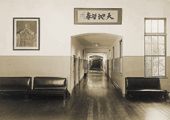 Hospital founded on the 2nd of June as Kurabo Central Hospital, with 83 beds (wards 1-3) and seven departments (internal medicine, surgery, gynecology, ophthalmology, pediatrics, otology, physiotherapy). Framed calligraphy entitled ‘Kaishun Tennchi,’ The Blessing of Spring, received from Viscount Shimpei Goto. Nurse training center opened. Dentistry department opened, bringing the total departments to eight. Rescue team deployed after the Great Kanto Earthquake. Hospital founded on the 2nd of June as Kurabo Central Hospital, with 83 beds (wards 1-3) and seven departments (internal medicine, surgery, gynecology, ophthalmology, pediatrics, otology, physiotherapy). Framed calligraphy entitled ‘Kaishun Tennchi,’ The Blessing of Spring, received from Viscount Shimpei Goto. Nurse training center opened. Dentistry department opened, bringing the total departments to eight. Rescue team deployed after the Great Kanto Earthquake. |
| 1924 | Two new wings constructed (wards 4-7). Isolation wing constructed as ward 8 (totaling 220 beds). KCH friendship society formed. |
| 1926 | 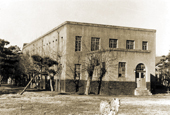 Laboratory facilities opened. Laboratory facilities opened. |
| 1927 |  Name changed to Kurashiki Central Hospital. Issue 1 of the Kurashiki Central Hospital Annals published. Name changed to Kurashiki Central Hospital. Issue 1 of the Kurashiki Central Hospital Annals published. |
| 1930 |  Asthma tower and purified air room for allergy patients installed. Asthma tower and purified air room for allergy patients installed. |
| 1934 | Reorganized as an incorporated foundation, with the hospital name changing to Kurashiki Central Hospital Foundation. |
| 1945 | Rescue teams deployed after air raids on Mizushima and Okayama and the atomic bombing of Hiroshima. |
| 1946 | Appointed as a designated training facility for the practical training of physicians. |
| 1949 | Certified as a general hospital. |
| 1950 |  Nurse Training center holds first capping ceremony. Nurse Training center holds first capping ceremony. |
| 1957 | Kokuga Hall completed for use as staff clubhouse. |
| 1963 |  Hospital’s 40th anniversary. At the commemoration ceremony, Soichiro Ohara, the Hospital Director said, “On our 50th anniversary, I expect to meet everyone again in a completely changed and even better hospital.” Hospital’s 40th anniversary. At the commemoration ceremony, Soichiro Ohara, the Hospital Director said, “On our 50th anniversary, I expect to meet everyone again in a completely changed and even better hospital.” |
| 1964 | Designated as an emergency hospital. |
| 1968 | Designated as a clinical training hospital. |
| 1969 |  In house newsletter Kaishun published. In house newsletter Kaishun published. |
| 1971 | Hospital facility overhaul and additions started. |
| 1973 | 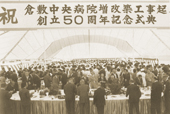 Commemoration ceremony held for the 50th anniversary of the hospital, along with an opening ceremony to commemorate the new hospital addition. Commemoration ceremony held for the 50th anniversary of the hospital, along with an opening ceremony to commemorate the new hospital addition. |
| 1975 | Ward 1 Building completed (971 beds). ICU and CCU opened. |
| 1977 | Medical records centralized. |
| 1978 | Database introduced. Start of intranet services, primarily for those areas handing payment. |
| 1980 |  Central ward completed. Central ward completed. |
| 1981 | Outpatient ward completed. Outpatient medical records centralized. |
| 1984 | Start of the ’KCH community outreach campaign’ |
| 1986 | Establishment of the Kurashiki Central Hospital Insurance Association. |
| 1987 | 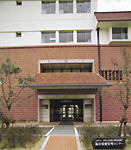 Establishment of the General Health Management center. Start of unit specifically for physical examinations. Establishment of the General Health Management center. Start of unit specifically for physical examinations. |
| 1989 | Operational regulations introduced and operational meetings started. Weekly newsletter Monday commenced. |
| 1991 | 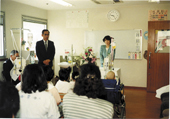 In-house school classes for child patients started. In-house school classes for child patients started. |
| 1992 | Ward 2 Building completed. Waraku Society for former staff established. Order-entry medical management system introduced. |
| 1993 | Received accreditation as an advanced medical treatment facility (Ministry of Health Labour and Welfare) Received accreditation as a prefectural medical insurance treatment facility (Okayama Prefecture) Opening of 24 hour hospital childcare facility. Sanwa Childcare center opened in close proximity to the hospital. |
| 1995 | 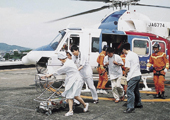 Heliport constructed (roof of Ward Building 2). Heliport constructed (roof of Ward Building 2).Kurashiki Central Outcall Nursing center opened. |
| 1996 | Designated as an AIDS treatment center. |
| 1997 | 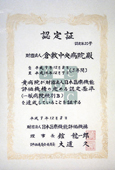 Designated as a prefectural disaster relief hospital. Designated as a prefectural disaster relief hospital.Web site opened. KCH starts accepting volunteer workers. Inspected by the Japan Council for Quality Health Care, resulting in full accreditation. |
| 1998 | 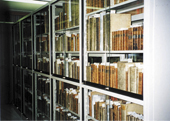 Hospital’s 75th anniversary. To celebrate this, the KCH emblem is introduced and the Gottingen collection of medical classics is procured. Hospital’s 75th anniversary. To celebrate this, the KCH emblem is introduced and the Gottingen collection of medical classics is procured. |
| 1999 | 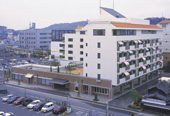 Accredited as a medical institution for class 2 infectious diseases (10 beds). Accredited as a medical institution for class 2 infectious diseases (10 beds).Aeon Kurashiki Clinic opened. Kurashiki Care center opened in collaboration with Kurashiki Central Tenjukai (Care House, Day center, and Home Care Support center). |
| 2000 | Internal medicine subdivided into specialist departments. With the aim of being a primary hospital for acute stage health care and to improve emergency care, the Surgery center, ICU, and NCU are expanded and reorganized into the Department of Emergency Medicine. Restructure of the Accident Prevention Committee (assignment of full-time risk management supervisor in the nursing division). Start of centralized bed control system. (Bed management assigned to nurse supervisor). Introduction of goal-based management system for staff, based on a new skills development program. KCH designated as Okayama's first comprehensive perinatal center. |
| 2001 | Midorinotsuta fax newsletter started and distributed to medical institutions. Publishing starts of K News, for patients and members of the community. First intake of interns accepted in anticipation of the 2004 requirement of mandatory clinical training for medical graduates. |
| 2002 |  Extension of outpatient Ward Building 1 and complete renovation of existing facilities in order to become a primary hospital for acute stage health care. Extension of outpatient Ward Building 1 and complete renovation of existing facilities in order to become a primary hospital for acute stage health care.Ten open beds allocated for regional partnerships. Declaration of patients' rights created. Regional Medical and Consultation center restructured and expanded. |
| 2003 | 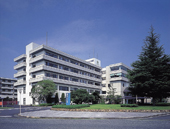 Medical library for patients opened. Medical library for patients opened.Re-inspected by the Japan Council for Quality Health Care, accreditation upheld. Kurashiki Riverside Hospital opened (140 beds). New medical data system fully operational. Medical safety Management Office established (two full-time staff and four rotating staff). Designated as a regional cancer treatment center. |
| 2004 | Improvement of Patient Satisfaction Committee (known as the KMCS Committee) established. Participated in a trial application of DPC (diagnosis procedure combination). |
| 2005 | 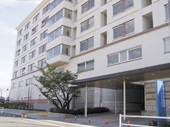 Night and holiday pediatric care services started, through community partnerships with local pediatricians. Night and holiday pediatric care services started, through community partnerships with local pediatricians.Establishment of a cardiac disease center to provide an increasing number of patients with a more advanced level of cardiovascular treatment. Establishment of Ward Building 9, an advanced medical facility. Ward Building 2 completely remodeled. Endoscopy center: Endoscopy examination rooms (10 rooms) remodeled to individual patient rooms. Waiting and examination rooms remodeled into a specialist laboratory. Dialysis center: Amenities improved, with the number of beds increased to 47. Hematology Ward: Addition of 3 bio-clean rooms with another 25 rooms (43 beds) as clean rooms. |
| 2006 | PET-CT (positron emission tomography) and 64 slice CT introduced. Establishment of the Clinical Research center. Second opinion service for outpatients commenced. Imaging facilities upgraded, along with the Imaging and Physiology center, prioritizing privacy and amenity. Establishment of the department of general medicine. |
| 2007 | Smoking prohibited throughout the entire hospital grounds. Establishment of a committee to promote a better working environment for female doctors. Abolishment of nursing caps. Re-inspected by the Japan Council for Quality Health Care for the third time, accreditation upheld. |
| 2008 | 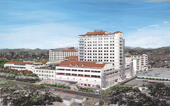 Formulation of a new medium term vision for the period of April 2008 to March 2013. Formulation of a new medium term vision for the period of April 2008 to March 2013.Construction of the new Ward Buildings 3 and 5 completed. Approved as a community medical support hospital. |
| 2009 | Medical Quality Standards department established. |
| 2010 | 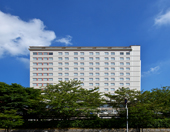 Received an Award of the Highest Excellence in the Facility Management Awards. Received an Award of the Highest Excellence in the Facility Management Awards.Awarded the 2009 Annual Ministry of Health, Labour and Welfare Award of Excellence of Service in Obstetrics. Genetic diagnosis unit and an outpatient chemotherapy unit established. The first hybrid operating theatre in the Chugoku and Shikoku regions of Japan procured. The neonatal unit of the Perinatal center allocated an additional 21 NICU and 30 GCU beds, making a total of 1151 beds. Construction of Ward Building 3 completed. |
| 2011 | Upgrade of medical record information system. |
| 2012 | Commencement of operations in the Ward Building 3 addition. Commencement of portal system for diagnostic images. |
| 2013 | Entry into “Hareyaka-net,” a prefecture based medical information referral network. Corresponding with the new regulations regarding public interest incorporated associations, corporation name is changed to Ohara HealthCare Foundation. Prefectural designation received for the Emergency and Critical Care center. The emergency ICU commences operation. |
| 2014 | Upgrades to the Neonatal ICU completed. “da Vinci” surgical system installed. 3 Tesla MRI introduced. Organizational restructure with professional streamlining and emphasis on patient services. Clinical research facilities incorporated into Ohara HealthCare Foundation as Kurashiki Clinical Research Institute. Cancer Nursing Clinic established. Upgrade of outpatient blood collection facilities complete. |
| 2015 |  Relocation of the Clinical Engineering Department Relocation of the Clinical Engineering DepartmentRegional Care Alliance formed between Soja City, Kibi Medical Association, Kurashiki Heisei Hospital and Kurashiki Central Hospital Establishment of the Oncology Center and commencement of oncology outpatient services Receipt of the Sanyo Shinbun Group Yoshiaki Matsuoka Award for the first time. |
| 2016 | Joint Commission International Accreditation Obtained. Five new beds allocated in a new Integrated Care Ward for trauma cases requiring specialist psychiatric care. DMAT 2 team dispatched and fundraising undertaken in response to the 2016 Kumamoto earthquake. Minimization of Radiological Exposure Hospital accreditation obtained. |
| 2017 | Hospital opened to the public for its first Open Hospital Day. Commencement of construction of the Preventative Healthcare Plaza. ISO15189 accreditation obtained by the Department of Clinical Laboratory. Commencement of online system for referral consultation bookings. Award of Excellence 2017 received from the Japan Institute of Healthcare Architecture. |
| 2018 | 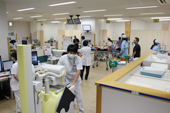 Response to the July 2018 flooding disaster. Response to the July 2018 flooding disaster.Hospital system crash results in the disruption of outpatient and emergency services. Hospital obtains accreditation as a Novalis Certified Radiosurgery Center. |
| 2019 | The Preventative Healthcare Plaza is officially opened. Agreement concluded with Kasaoka City and its Medical Association for hospital participation in jurisdictionally-controlled regional care networks. Commencement of training in order to increase the clinical privileging of nursing staff. |
| 2020 | Responding to COVID-19 Patients. Kurashiki Central Nursing College moved to new school building. |
| 2021 | Responding to COVID-19 Patients. Commencement of operation of chimeric antigen receptor-T cell therapy. |
| 2022 | Responding to COVID-19 Patients. Commencement of construction to commemorate the 100th anniversary of the foundation. |
| 2023 | In commemoration of the 100th anniversary, we held a symposium jointly with Center for iPS Cell Research and Application, Kyoto University and relocated Miwa nursery school to a new building. Participants of the G7 Kurashiki Labour and Employment Ministers' Meeting visited our hospital. We received the Quality Achievement Award for 2023 from the European Society for Quality Research. Crowdfunding for the construction of a watertight wall. |

